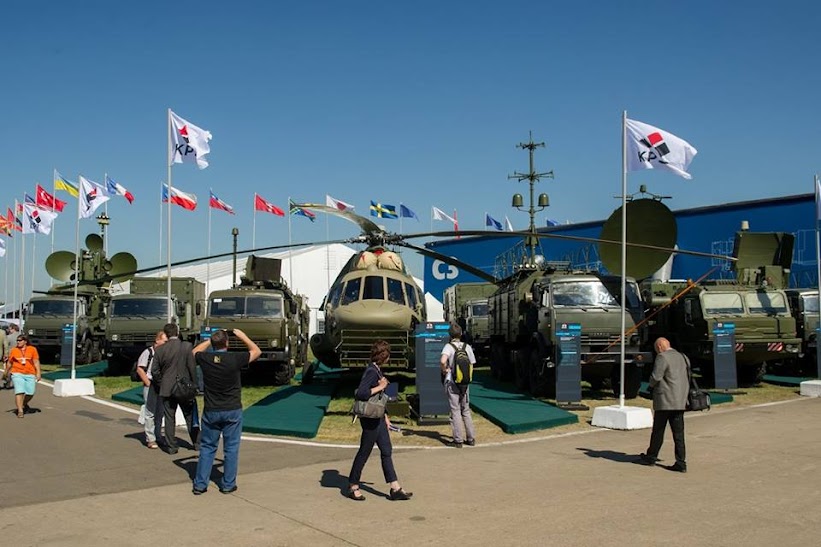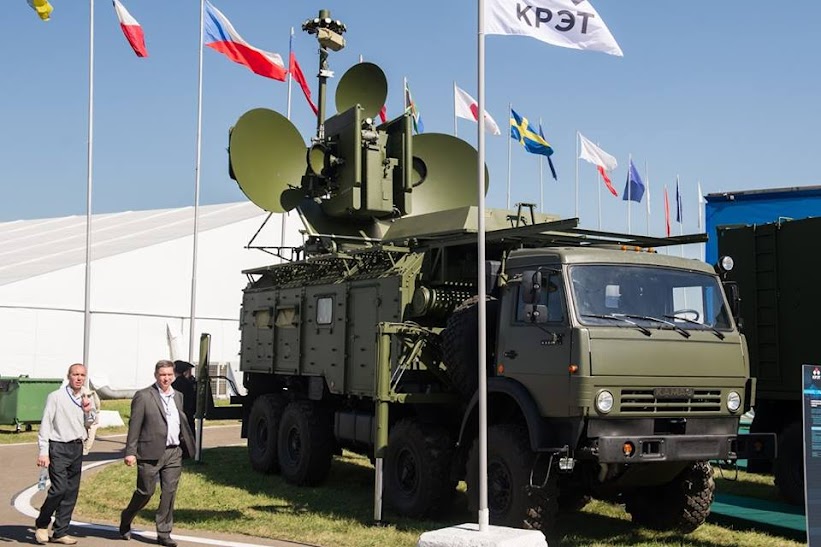 |
| KRET EW Systems on display at MAKS-2015 |
Russian EW systems displayed at MAKS 2015 suggest that Russia has adopted a low cost, asymmetric approach to counter the threat posed by the soon to be deployed F-35 fighters, which features low observability (LO) and sensor fusion.
A low observable (LO) fighter can escape detection only if it keeps its radar switched off, or under emission control (EMCON). To penetrate contested airspace and attack targets, the LO fighter relies on an AWACS positioned in the rear, which streams the air and ground situation over a directional and encrypted data link. The LO fighter uses its sensor fusion capability to fuse the information obtained from the AWACS sensors with the information obtained through its own passive (ESM, EO) sensors to track and engage adversary targets.
An F-35 strike force under AWACS cover would be able to detect and engage non stealthy Russian fighters - MiG-35, Su-30, Su-35 - well before the Russian fighters detected the presence of the strike force. The F-35s would detect the Russian fighter radar emissions from as far away as 300-nm. Non emitting Russian fighters would be picked up by the F-35 strike force support AWACS from 150-nm.
Even if the Russian fighters were also supported with AWACS, the F-35s LO would delay detection till around 90-nm.
The challenge to Russia from US LO fighters is formidable, but it's noteworthy that LO is fundamentally an ECM technique. LO fighters deflect radar emissions away from the transmitter, instead of bouncing them back to the transmitter.
If LO is ECM then common wisdom hold that every ECM has a ECCM!
The Russians have chosen to negate US advantage, not by building analogs, but by reverting to fundamentals.
A stealthy F-35 strike force threatens ground targets so why oppose it from the air? Putting powerful jammers and passive locators on the ground in the proximity of high value targets that the adversary fears and wants to target would be a logical. Ground based systems have practically no size and weight constraints, as long as mobility is ensured.
What the Russians appear to be doing is:
- Fielding powerful ground based jammers to degrade AWACS sensors, data links, RF missile sensors.
- Fielding ground based passive emission locating systems that constrain enemy use of radar.
- Developing UAVs featuring UHF, L, S radars to unmask LO fighter aircraft
- Fielding more sensitive Electro Optical Targeting System (EOTS) on their fighters.
The following are some of the new weapon systems displayed at MAKS 2015 that are focused on mitigating the threat posed by the advent of F-35s in large number along Russian borders.
 |
| Krasukha Jammer at KRET pavilion at MAKS-2015 |
Krasukha EW System
The Krasukha is a mobile, ground-based broadband multi-functional jamming station and spoofing system developed by KRET. The system analyzes the type of signal and responds by jamming it with a powerful, smart interfering emission, preventing adversary radar sensors from detecting targets and guiding weapons to them.
There are two variants of the system: Krasukha-2 and Krasukha-4, the latter being a higher power longer range system.
Krasukha is effective against the entire spectrum of RF dependent weapon systems. It can jam radars (ground, low orbit satellite, AWACS, Fighter, UAV, Missile), data links and satellite links. Krasukha RF suppression makes PGM guidance impossible.
The system can vary jamming intensity to extremes and is capable of damaging electronics through brute force pumping of RF energy into enemy system. Krasukha can also be subtle; for example, it can generate false targets to spoof missile RF sensors.
Jamming range for AWACS is claimed to be 300-km for the Krasukha-2 system, and 400-km for the Krasukha-4 system.
Krasukha systems were developed to protect high value targets on the move, such as the Russian tactical missile Iskander (SS-26), while on the move.
LO UAV to Detect LO Fighters
Russia's UAC is reportedly developing a LO UAV designed to detect stealth aircraft using X-band and UHF radars. The project is an analog of China’s “Divine Eagle” project.
The Russian UAV would detect LO aircraft such as as Lockheed Martin F-22 and F-35 and Northrop Grumman B-2.
KRET is developing a deeply-integrated electronic warfare system that would create a protective electromagnetic sphere around the UAV to counter air-to-air missiles and cloak it from radars.
Avtovaza-M
The Avtovaza-M is a Emitter Location System (ELS) that can passively detect and track adversary aircraft facilitating engagement by AD missiles. The system comprises five vehicles spread over tens of kilometer, interconnected over low-power, low-probability-of-intercept communication link using antennas mounted on tall masts.
Avtobaza-M uses time-difference-of-arrival (TDOA) processing to locate targets with a precision that is about 2% of detection range, and operates from 200 MHz to 18 GHz and has a range of up to 150-km.
In its basic configuration, Avtovaza-M includes four autonomous SOP (Stantsiya obnaruzheniya i pelengovaniya) detection and direction finding stations and one SOI (Stantsiya obrabotki informatsii) information processing station (ESM), mounted on Kamaz-63501 four-axle military trucks.
TDOA systems can locate targets with three stations, but the Avtovaza system uses up to five, to provide redundancy and resolve ambiguities.
The system can detect, analyze and track IFF, TACAN, pulse and continuous onboard radar emissions, and determine radar types for air and sea surface targets, and then disseminate all of this data up the air defense chain.
The whole system can be set up or made ready to redeploy in 45 minutes, with just 3 to 5 minutes to bring it into combat readiness.
The Avtobaz system is believed to have been used by Iran to bring down an American RQ-170.
The usefulness of an ELS system is often underrated because it cannot detect or track a non emitting aircraft - for example, an adversary fighter with its radar, IFF and JTIDS/Link-16 switched off. The point overlooked is that with its radar or data link offline, the adversary fighter wouldn't be able to engage targets!
Moscow-1
The Moscow-1, the successor to the Avtobaza-M ELS, can detect targets at a distance of 400 km, as against Avtovaza's maximum range of 150 km.
Moscow-1 system is operated by a crew of 4 and consists of three trucks including an ESM vehicle (IL265E) and an airborne radar jammer (IL2663). The station is able to provide 360-degree visibility and can be deployed in 45 minutes.
You can see more pictures of the Krasukha system at this AW&ST link.
Analysis
If the above logic behind powerful ground based EW systems is sound, why has the US not developed such weapon systems.
Bill Sweetman in his audio-interview (link below) attributes it to the expeditionary nature of US forces. US ground troops are loathe to carry around anything larger than a Humvee sized vehicle, says Sweetman.
A KRET official confirms as much in a more recent interview, excerpted below from a Google translation.
Apparently this is explained by the history of US involvement in military conflicts. They are known in their territory do not fight, and are mainly involved in any global or local military conflicts far from their borders. Therefore, the terrestrial EW they never paid as much attention as we do. Perhaps this is also dictated by the current military doctrine there. We have a different doctrine, is defensive in nature, so the means of electronic intelligence and management of land-based we have developed very well. We can say - as anywhere in the world.
Bill Sweetman on how Russia is countering US Advantages
Russian EW Systems - IDP Sentinel members only link
No comments:
Post a Comment